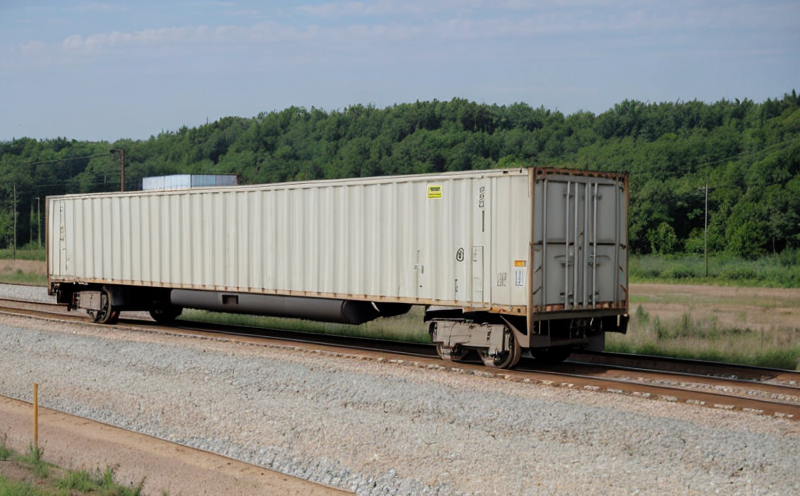UIC 576 Running Performance Testing under Load
The UIC (Union Internationale des Chemins de Fer) Standard 576 is a comprehensive framework that evaluates the running performance of freight wagons and similar railway vehicles. This service focuses on assessing how these wagons behave when subjected to operational loads, which includes evaluating their structural integrity, braking efficiency, acceleration capabilities, and dynamic stability.
For quality managers, compliance officers, R&D engineers, and procurement teams involved in railway and transportation systems, this test ensures that the vehicles meet stringent safety and performance criteria. This is critical for ensuring safe operations on any rail network. The UIC 576 standard is internationally recognized and widely used by both manufacturers and regulatory bodies.
The testing process involves simulating real-world conditions with controlled environments to assess how well a wagon can perform under stress. This includes not only the static load but also dynamic loads that occur during actual rail travel. The goal is to identify potential issues before they lead to operational failures or safety hazards.
During the test, various parameters are monitored and recorded. These include speed profiles, acceleration rates, braking distances, wheel slip percentages, axle loads, and more. By analyzing these metrics, engineers can pinpoint any areas where improvements need to be made or adjustments required for optimal performance.
The running performance testing under load also involves detailed inspections of the wagon's components such as axles, bogies, couplings, and other parts that come into direct contact with the track. These checks ensure that all elements are functioning correctly and safely within specified limits defined by UIC 576 standards.
Another crucial aspect of this testing is the evaluation of the wagon's interaction with the rail system itself. This includes assessing factors like wheel-rail contact forces, lateral stability during sharp curves, and overall smoothness of ride quality. All these elements are vital for maintaining high levels of efficiency and safety throughout each journey.
Once completed successfully, this testing process provides valuable insights into the performance capabilities of a wagon. It helps manufacturers identify strengths as well as weaknesses which can be addressed through design modifications or operational adjustments. Moreover, it serves as an essential tool during certification processes required by various national railway authorities around the world.
Applied Standards
The UIC 576 standard is based on several internationally recognized standards including ISO, EN (European Norm), and ASTM guidelines. It ensures that all aspects of running performance testing are covered comprehensively and consistently across different regions.
- ISO 14908: This international standard provides guidance on how to conduct fatigue tests on railway axles which is a key component in UIC 576.
- EN 13262: Covers the general requirements for railway wagons including structural integrity checks that align with UIC 576 objectives.
- ASTM E456: Provides definitions and principles applicable to standards for materials, products, systems, and services which supports accurate measurement techniques during testing.
The application of these standards ensures uniformity in practice across different countries while adhering strictly to the latest advancements in railway technology. Compliance with UIC 576 means meeting both local regulations as well as international best practices.
Scope and Methodology
| Parameter | Description |
|---|---|
| Load Simulation | The test simulates various loads the wagon might encounter during operation, including static and dynamic forces. |
| Speed Profile | The vehicle is subjected to different speeds to assess its ability to maintain stability at varying velocities. |
| Braking Efficiency | The effectiveness of the braking system is evaluated by applying standard stopping distances and observing deceleration rates. |
| Axle Loads | The distribution of weight on individual axles is measured to ensure they do not exceed safe limits. |
| Wheel-Rail Contact Forces | This measures the interaction between wheels and rails under load conditions, ensuring proper contact for smooth operation. |
The methodology involves setting up a controlled environment where environmental factors like temperature, humidity, and elevation can be precisely regulated. The testing equipment used includes advanced sensors capable of capturing minute changes in performance parameters throughout the duration of each test run. Post-test analysis is conducted using sophisticated software tools designed to interpret data collected during the trial runs.
This approach ensures accurate results that reflect real-world conditions experienced by freight wagons on operational railways. By following this standardized procedure, laboratories can provide reliable and consistent assessments of wagon performance across different models and configurations.
Use Cases and Application Examples
- New Vehicle Development: When introducing a new design or model to the market, UIC 576 testing ensures that all components meet required specifications before going into production.
- Pre-Operational Testing: Before entering service on any railway network, wagons must pass this rigorous evaluation process to ensure compliance with local and international standards.
- Regulatory Compliance: Many countries mandate UIC 576 certification as part of their regulatory framework for railway transportation. Passing these tests is essential for obtaining necessary permits.
- In-Service Monitoring: Periodic retesting allows operators to monitor the condition of existing fleets over time, identifying any signs of wear or deterioration early on.
These use cases highlight the importance of UIC 576 testing in ensuring safe and efficient railway operations. For quality managers responsible for maintaining high standards within their organizations, this service offers a critical tool for achieving regulatory compliance and enhancing overall operational reliability.





